June 2022 / ESG
ESG Integration in Action—Circular Economies
How a circular model could support economic and population growth.
Executive Summary
If global economies are to prosper and support increasing populations, the world must move away from linear processes and shift to a circular model. In this ESG Integration in Action white paper, we demonstrate how our in‑house research and stewardship activities evaluate three principal themes within the circular economy—sustainable agriculture, plastics, and the energy transition. The paper explores the global need to eliminate waste and pollution, circulate products and materials, and regenerate nature—while ensuring a transition to renewable energy and materials to help decouple economic activity from the consumption of finite resources.
The vast majority of economic activities are built on a linear model, where raw materials are taken from the earth, used to make products, and eventually discarded. This source of environmental degradation is worsening as the global population grows, signaling that this linear model is not sustainable. If global economies are to prosper and support the world’s burgeoning population, a shift to a circular economy is needed.
The circular economy is based on three principles— eliminating waste and pollution, circulating products and materials, and regenerating nature. It underpins a transition to renewable energy and materials, helping to decouple economic activity from the consumption of finite resources. This white paper is divided into three sections, exploring the following key themes: Sustainable Agriculture, Plastics, and the Energy Transition.
SUSTAINABLE AGRICULTURE
Sustainability in the agricultural sector is a challenging web of considerations. On the one hand, agriculture accounted for 18.4% of global greenhouse gas (GHG) emissions (in 2016),1 alongside ecosystem loss and land degradation. It also accounts for 70% of all freshwater withdrawals2 and is the largest contributor to nutrient runoff (a process that creates toxic algal blooms as well as “dead zones” in aquatic ecosystems). On the other hand, agriculture is a powerful force for good. It provides the food we all need to survive and has an outsized role in reducing poverty. The United Nations forecasts food demand to increase more than 50% by 2050, if the global population grows to an expected 9.8 billion (from 7.7 billion in 2021) and incomes increase across emerging markets. As investors, we can play a role in directing capital toward agricultural projects that can help close that food gap, but we also must ensure that our investment is being deployed sustainably. Investing in the same agricultural practices of the past 50 years will only serve to exacerbate the sector’s negative impacts—eventually leaving both society and investors to suffer the consequences.
Increasing food production by more than 50% without a radical change in traditional farming practices would require an enormous amount of land conversion and a sizable increase in GHG emissions. Neither is compatible with limiting global warming to a maximum target rise of 1.5°C. Indeed, most scenarios imply that agricultural emissions need to contract by half from 2016 levels, alongside reforesting 585 million hectares of land. There are a range of sustainability issues that we believe will impact companies, and each can vary substantially in how they impact the business (such as a binary event or compounding pressures). For example, a food company may face earnings volatility driven by a commodity shock resulting from physical climate risk, or it may face a steady, gradual shift in consumer preferences.
At T. Rowe Price, our equity and credit analysts consider sustainability issues related to agriculture, forestry, and other land use (AFOLU) as part of their fundamental investment research. Often, they receive support from our environmental, social, and governance (ESG) specialists when considering how AFOLU issues may impact specific industries or securities.
Greenhouse Gas Emissions by Source (2016)
Agriculture is a big contributor to GHG emissions
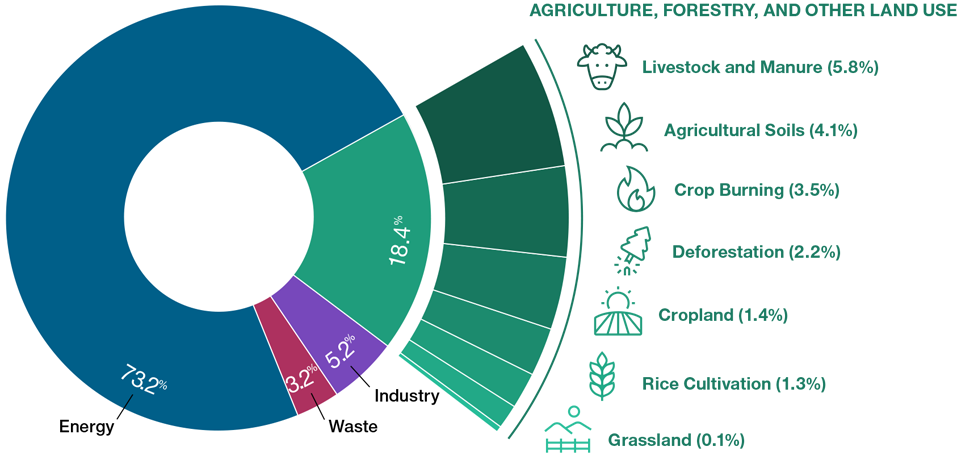
As of September 2020.
Source: Our World in Data (September 2020). Data as of 2016—most recent data available.
Sustainable Agriculture in RIIM
In addition to our investment analysts’ fundamental research, sustainable agricultural factors are systematically identified in our Responsible Investing Indicator Model (RIIM). They are key factors in our ESG analysis of the food, beverage, and related retail industries and the chemicals sector. They also come into play in sectors contributing to new agricultural technologies like industrials and information technology.
Sustainable Agriculture Factors Featured in RIIM
Primary AFOLU‑related data inputs*
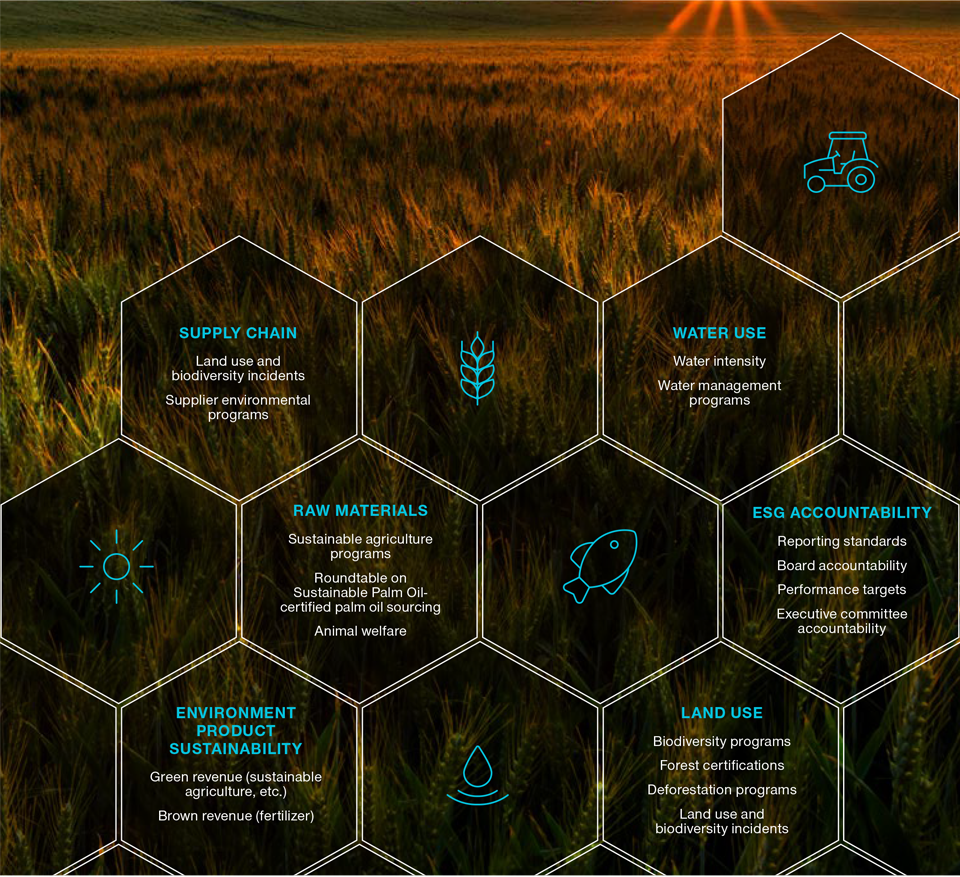
*Non‑exhaustive list.
Source: T. Rowe Price.
Building a RIIM Profile—Bunge (Case Study, June 2021)
Evaluating a company’s practices concerning sustainable agriculture isn’t always straightforward. Given the scale, complexity, and diversity of agricultural supply chains, we regularly see evidence of corporate management of the issues coupled with controversies.
In 2021, we found one company, Bunge, in such a situation. Bunge is an American agribusiness with international operations in soybean exports, food processing, grain trading, and fertilizer. External ESG ratings providers took very different views on the company, with one giving Bunge top marks (AAA rating) and another giving the company its second‑worst possible rating (high risk). Our RIIM analysis, meanwhile, rated Bunge as green overall with its score having improved gradually over past years. However, multiple categories in our model flagged orange due to Bunge’s exposure to deforestation controversies. Its environment and social scores also fell toward the bottom of green‑rated territory.
RIIM puts a high level of materiality (the ESG factors we consider to matter most) on the company’s supply chain management (both environmental and social), as well as raw materials procurement, product sustainability, and society and community relations. RIIM flagged nongovernmental organization reports alleging multiple incidents of deforestation and biodiversity loss throughout the company’s supply chain, especially in sensitive regions of South America and Indonesia. RIIM also pulled in quantitative data evidencing Bunge’s supply chain management practices, which we fortified with our own fundamental assessment and stewardship activities.
Bunge RIIM Profile
Evaluating sustainable agriculture practices
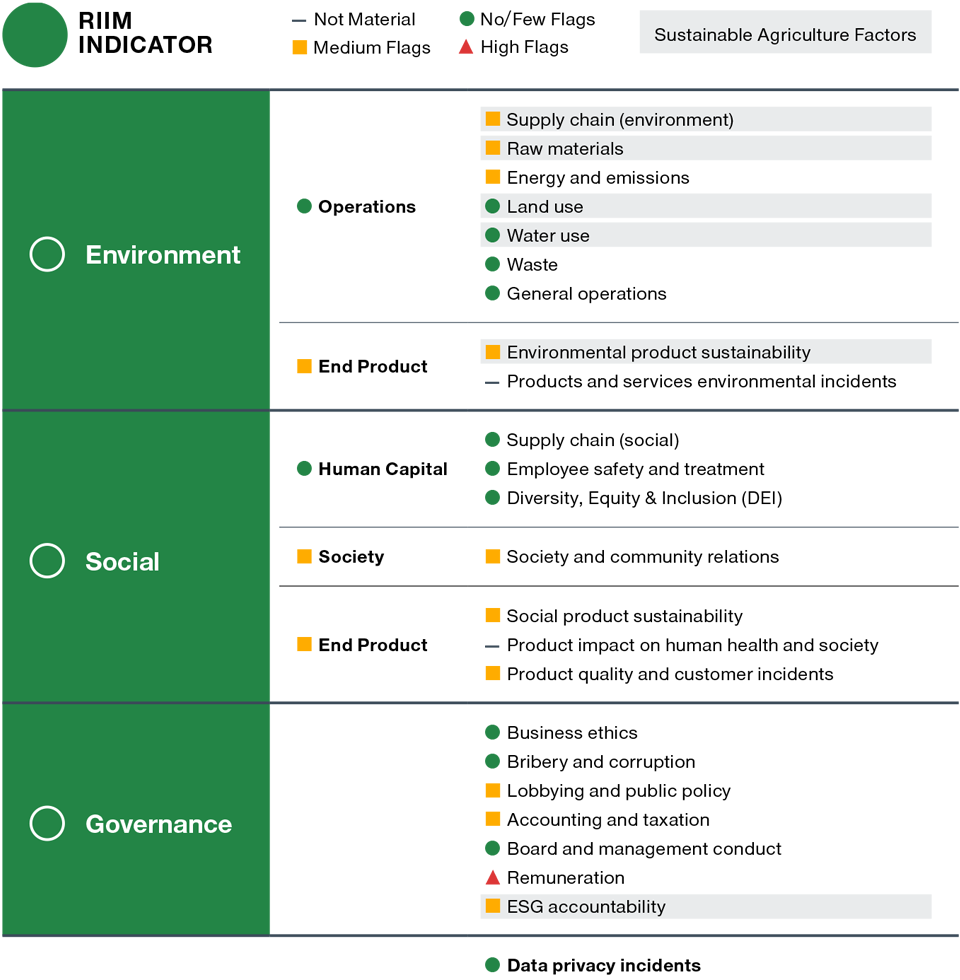
The security identified and described is intended to illustrate the RIIM and does not necessarily represent securities purchased or sold by T. Rowe Price. No assumptions should be made that the security analyzed, or other securities analyzed, purchased, or sold, was or will be profitable. The RIIM profile is not a recommendation to buy or sell any security and is not indicative of a company’s potential profitability. It measures ESG factors only.
The RIIM profile is as of June 2021, is provided as a historical example only, and is subject to change.
Engaging With Bunge
In May 2021, we engaged Bunge on deforestation and supply chain management. We wanted to better understand Bunge’s ambitions and convey that deforestation and human rights are material in our investment analysis.
The Intergovernmental Panel on Climate Change estimates that agriculture, forest, and other land use accounted for about 13% of the world’s carbon emissions and 23% of total GHG emissions between 2007 and 2016. AFOLU activities are the dominant contributors to deforestation, which impedes the ability for the world’s land sinks (forests, croplands, and wetlands) to absorb carbon from the atmosphere. Between 2007 and 2016, natural terrestrial carbon sinks are estimated to have offset 28% of human‑generated emissions.3
Outcome
We learned that Bunge had an ambitious target for a deforestation‑free supply chain by 2025, including legal deforestation. The company established a palm oil dashboard providing robust disclosure on its palm oil mills and addressing accusations of deforestation or biodiversity loss. Beyond disclosure, Bunge discussed its engagement with suppliers, demonstrating a commitment to cut ties with suppliers that fail to address breaches in policy compliance.
On social supply chain management, the company demonstrated strong standards, but it scored poorly in this category in RIIM due to shortcomings in applicability to indirect suppliers and lack of audits. The score was further compounded by repeated reports of forced and child labor use among suppliers. Encouragingly, however, Bunge indicated plans to conduct a human rights assessment to improve supply chain management and committed to supplier audits starting in 2021.
We were encouraged by the measures to eliminate deforestation and human rights abuses in its supply chain. As Bunge is an agribusiness, these are two significant ESG risks we continue to monitor.
Before the company’s May 2021 annual shareholder meeting, we had another opportunity to engage with Bunge on the topic of deforestation. The company had received a shareholder resolution seeking additional reporting on its exposure to deforestation risk related to soy production. As the company spoke with its largest investors about the issue, the board understood our interest in additional disclosure on this topic and elected to recommend in favor of the shareholder resolution. With the company’s support, the resolution received overwhelming support from 98% of shares voted.
Collaborative Engagement on Food Sustainability
In 2021, AFOLU issues featured prominently across our stewardship activities. We held 75 engagements with 65 companies during the year covering issues such as deforestation and sustainable agriculture.
These included collaborative engagements. One was conducted through the Farm Animal Investment Risk and Return (FAIRR) initiative, a global network of investment organizations that actively engages with the world’s largest food retailers and manufacturers about ESG risks within the global food sector, particularly those associated with intensive livestock production. Another was conducted through the Emerging Markets Investors Alliance (EMIA), a not‑for‑profit organization that enables institutional emerging market investors to support good governance, promote sustainable development, and seek to improve investment performance in the governments and companies in which they invest.
PROTEIN DIVERSIFICATION
In a collaborative engagement, conducted through FAIRR, we signed letters to many of the world’s major food retailers urging them to grow their share of sustainable, plant-based proteins and build out their strategy.
The companies we engaged with included Conagra, Costco, Walmart, Wm. Morrison, Carrefour, Casino, Kerry Group, Sainsbury’s, Ahold Delhaize, Nestlé, Tesco, Unilever, Woolworths, Kraft Foods, Kraft Heinz, and Coles.
Protein diversification involves the transformation of portfolio composition by shifting away from an overreliance on resource-intensive animal proteins toward lower-impact protein ingredients and products. These include plant-based, cell-cultured, fungal-based, and whole-plant alternatives to meat, dairy, seafood, and other animal proteins.
We have been pleased to see many of these companies set board-level, public commitments around portfolio transformation.
All 25 companies within FAIRR’s scope of engagement now recognize protein diversification as a material issue for their businesses, compared with none five years ago.
SUPPLY CHAIN MONITORING IN THE AMAZON
In a collaborative engagement, conducted through EMIA, we sought to:
- Engage protein producers about material ESG issues
- Provide protein producers with a forum to communicate their policy intentions and actions and receive feedback
- Highlight hurdles to the implementation of best practices and discuss the role investors can play in changing government policy
The companies included JBS, Marfrig, and Minerva.
Ruminant livestock (cattle, sheep, and goats) account for roughly half of agriculture’s greenhouse gas emissions and use about two-thirds of global agricultural land.4 Deforestation has caused almost half of Brazil’s carbon emissions in the last 30 years, with the loss of more than 780,000 square kilometers of forest and 2,000 species. Pasture expansion for cattle production has been linked to 80% of clearing.5
The engagement informed our research and allowed us to impart the message that supply chain monitoring is a material factor in our investment analysis for the sector.
PLASTICS
Plastics can play a positive role in some sustainability issues, including reducing food waste, reducing product weight to enable more efficient transportation, improved building materials, or better hygiene. However, their sheer volume of production and non‑degradable nature means they have come to epitomize the problems of the end‑to‑end (or linear) economy.
When thinking about the three principles of the circular economy—eliminating waste and pollution, circulating products and materials, and regenerating nature—many tend to associate plastics with the first two. They view the plastics problem from the perspective of recycling and product life‑cycle design. Yet, plastics fundamentally violate the third principle as they introduce a non‑degrading substance into the natural world.
Global Plastics Ultimate Disposal
Plastic packaging—an enemy of the circular economy
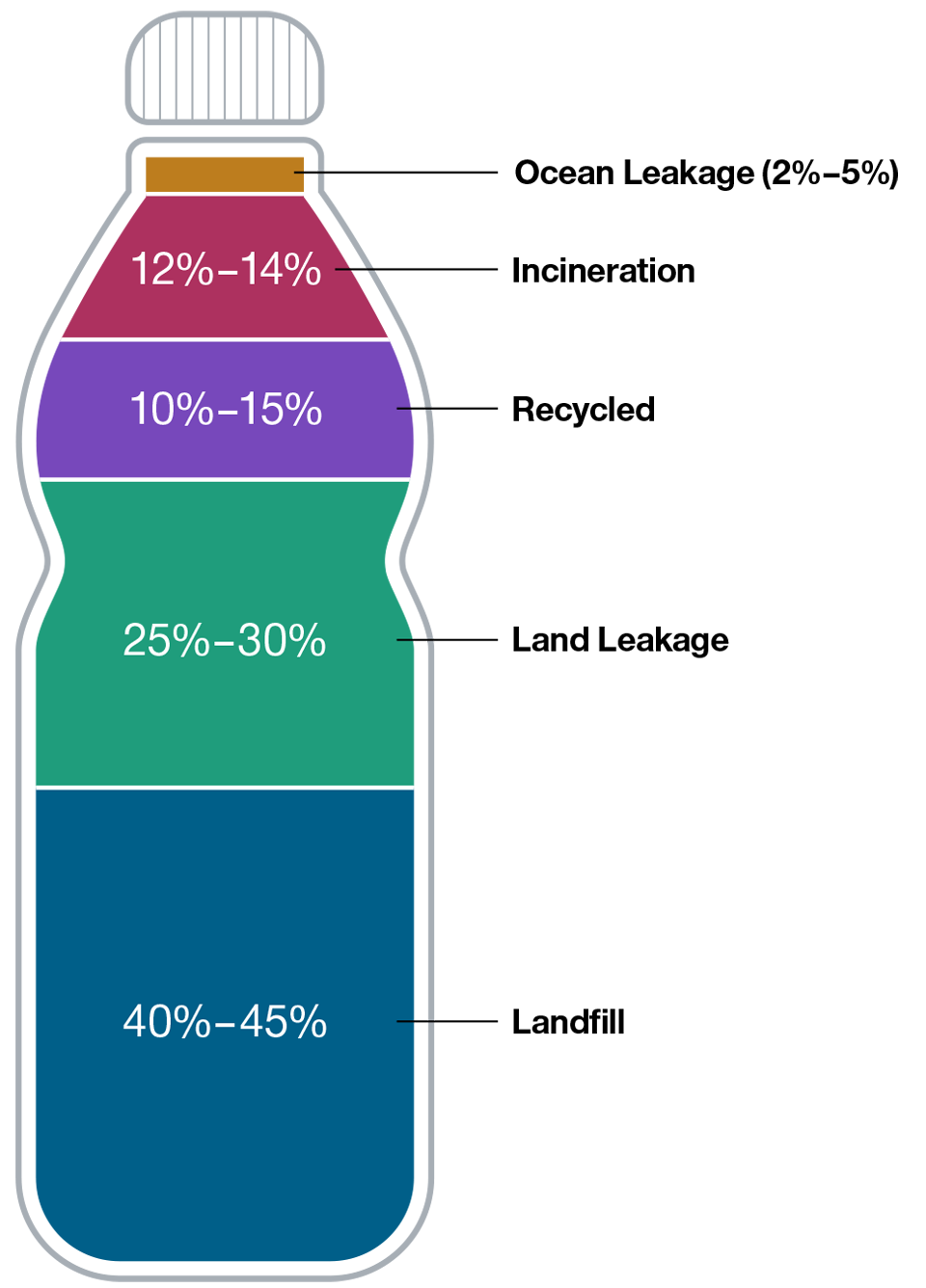
As of 2018.
Source: The New Plastics Economy, Ellen MacArthur Foundation, 2018.
Most recent data available.
Less than 2% of plastics currently come from bio‑based materials. The remainder are derived from fossil fuels, which are broken down with energy‑intensive processes and then mixed with chemicals to create different types of plastics. The resulting synthetic product is not found anywhere in nature and does not easily decompose. Plastics can break into smaller parts but cannot break apart. The large‑scale production and poor practices around disposal have made plastic a ubiquitous substance in nature—so much so that plastics are a marker of the current geological era6 and have given rise to a new microbial habitat known as the plastisphere.7 After climate change, plastic pollution may be the next biggest environmental crisis. Due to the multiple and cascading risks posed by plastic pollution, it is seen as a multiplier that can act in tandem with other stressors like climate change and overexploitation of marine resources to cause far greater damage than if each occurred in isolation.8
The Ellen MacArthur Foundation estimates that 95% of plastic packaging material is lost to the economy after its first use. As such, plastic packaging has become an enemy of the circular economy and has prominently entered the crosshairs of consumers and regulators. Over one‑third of global plastic use is in the packaging sector. As regulators address the plastics issue and consumers become more aware of the sustainability pressures plastic packaging presents, we expect the single‑use plastics space to be radically reshaped in the coming decade as companies use alternative materials (paper, aluminum, etc.), innovate better plastics (bioplastics, etc.), and use less packaging material altogether.
International collaboration plays a crucial role in the fight against plastic pollution. That’s why the outcome of a recent United Nations Environment Assembly is a positive step forward toward tackling the problem. In March 2022, 175 countries agreed to draw up a global and legally binding treaty to end plastic pollution—with a view to finalizing the treaty by the end of 2024.
Plastics in RIIM
One of our internally developed databases feeding our RIIM analysis is devoted to packaging statistics and targets for consumer products companies. The database has a strong focus on household and personal care (HPC) companies, where consumer preferences have been most pronounced. Over half of the HPC companies in the MSCI All Country World Index specifically mentioned that they were motivated to improve the sustainable profile of their products due to increased consumer interest in the environmental footprint of their purchases. Many see sustainable packaging as a way to meet consumer expectations.
We expect companies that disclose targets and progress related to sustainable packaging will likely see greater growth and returns in the long run as consumers increasingly consider the environmental impact of packaging in purchasing decisions. These companies will also be less financially impacted by regulation and taxation that seek to restrict plastic use and increase recyclability.
As an input into RIIM, data related to packaging targets are readily available to our equity and credit analysts covering the consumer products industries. Importantly, we recognize that the change needed to address the environmental crisis created by plastic packaging is not as simple as switching materials, nor can the long‑term solution sit squarely with recycling. Understanding a company’s long‑term packaging plans is an important part of our analysis.
Plastics‑Related Factors Featured in RIIM
Primary plastics‑related data inputs*
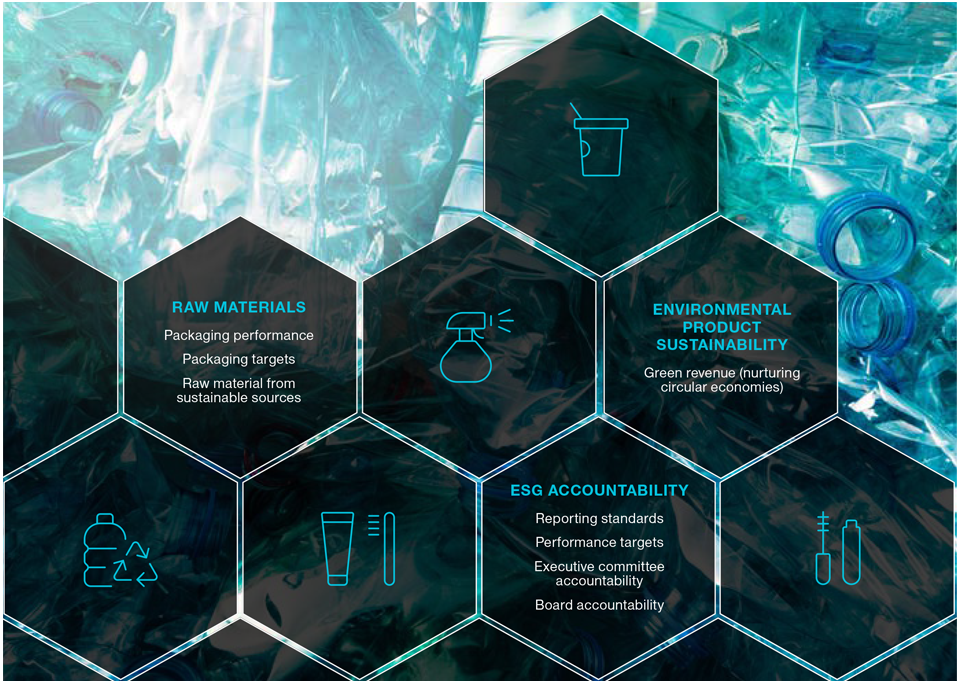
*Non-exhaustive list.
Source: T. Rowe Price.
Many leading companies within the HPC industry expect to complete full overhauls of their packaging between 2025 and 2030. Businesses have responded to changing consumer preferences and expectations by switching to alternative materials such as aluminum or paper. Meanwhile, others have adopted new policies, like eliminating plastic bags entirely, as they simultaneously make other changes to their products or supply chains. More meaningful changes will come with the help of technological breakthroughs and rethinking of the packaging equation (including reusable/refillable solutions).
Plastic‑Intensive Industries Are Responding in Different Ways
Innovations in the HPC sector
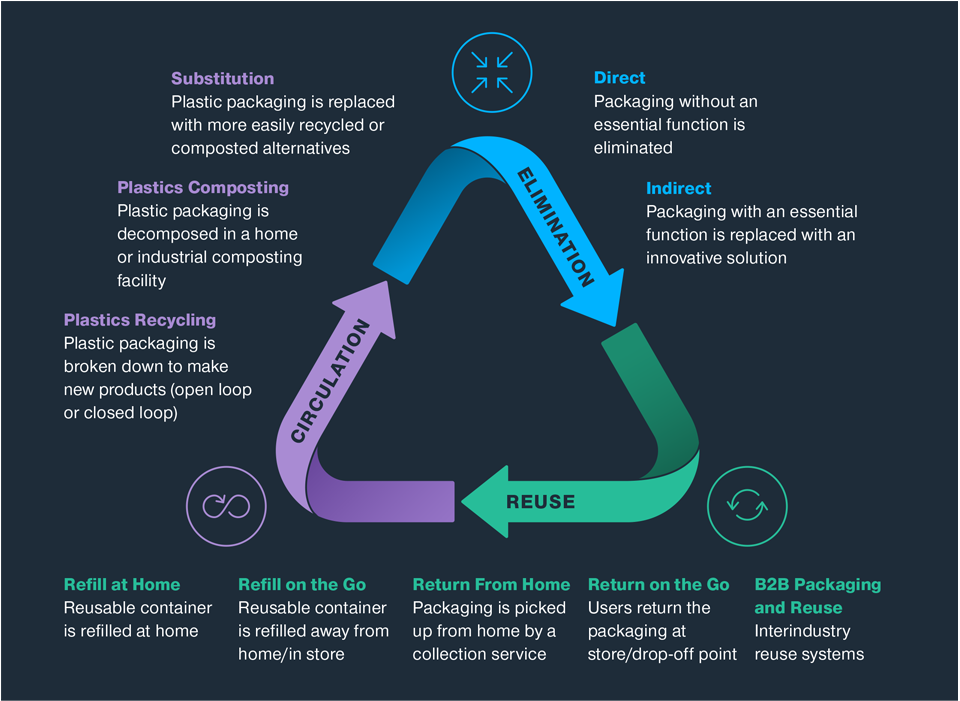
As of September 2021.
Source: Original diagram sourced from the Ellen MacArthur Foundation website, September 2021. The diagram is reproduced by T. Rowe Price specifically fo rinclusion in this article, and its use does not reflect the views of the Ellen MacArthur Foundation nor does it reflect or imply the foundation’s endorsement.
Plastics and Stewardship Activity
Our engagement on single‑use plastics
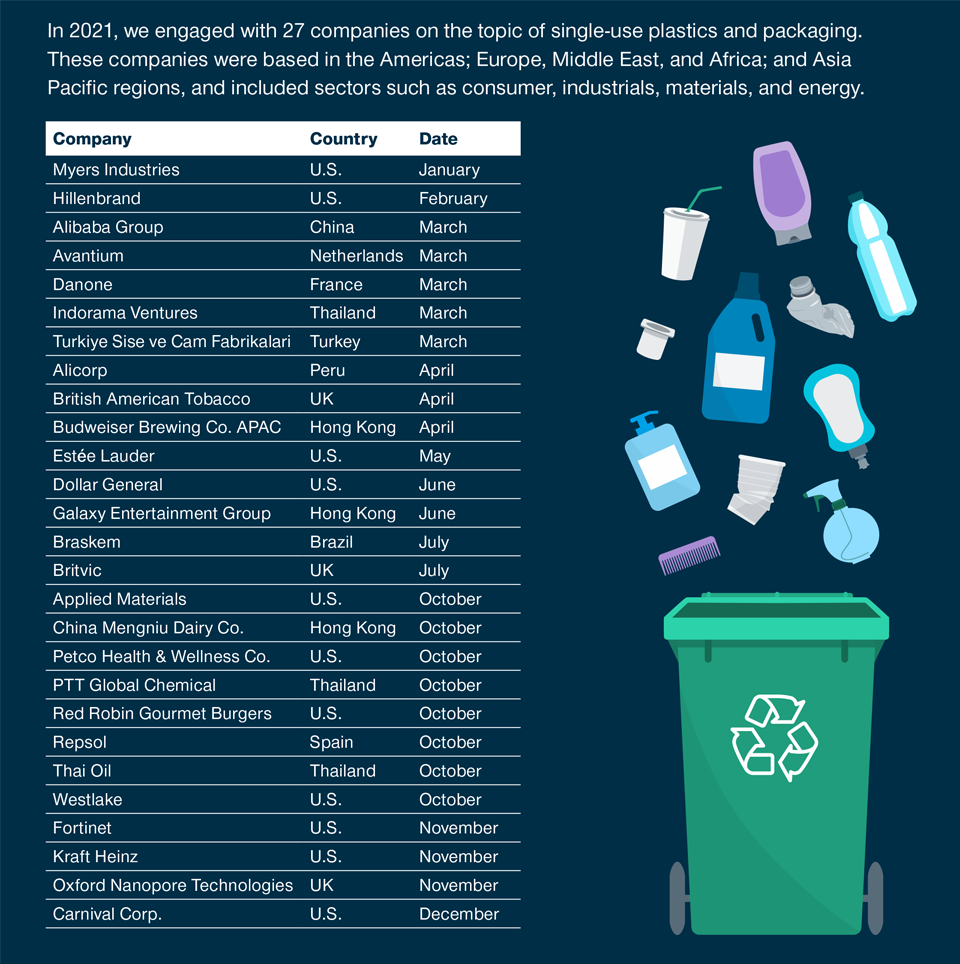
As of September 2021.
The specific securities identified and described are for informational purposes only and do not represent securities purchased, sold, or recommended by T. Rowe Price. No assumption should be made that the securities identified were or will be profitable.
ENERGY TRANSITION
A cornerstone of the circular economy is that it needs to be underpinned by a shift to renewable energy. Energy transition is an issue that permeates all sectors and asset classes.
To limit global warming to a maximum rise of 1.5°C, carbon dioxide emissions must be contained to defined levels over a period of time—this is known as the world’s carbon budget. Assuming a two in three probability of staying within the 1.5°C scenario and with greenhouse gas emissions at 2021 levels, the world’s carbon budget will be exhausted in just six years. The figure jumps to 16 years assuming a one in three probability.
The finite nature of the carbon budget emphasizes the urgency for the energy transition effort and the need to bend the emissions curve quickly. The upshot is that, to stay within a 1.5°C global temperature rise, the world needs to reduce greenhouse gas emissions by 50% by 2030 and achieve net zero emissions by 2050.9
For Europe, Russia’s invasion of Ukraine has only added to this sense of urgency, with the conflict resulting in oil and gas price shocks and sparking fears over security of supply from Russia.
The Russia‑Ukraine conflict has proved deeply concerning. First and foremost is the humanitarian crisis and the egregious impact that events have had on the well‑being of people caught in the midst of the combat. While we continue to assess the overall, long‑term ESG implications, one thing has become clear: The conflict has the potential to accelerate the energy transition—particularly in Europe. Russia accounts for 12% of global oil production and 18% of global natural gas production.10 Given its proximity, the European Union’s dependence on Russian oil and gas supplies is high. In 2020, more than half of Russia’s oil exports and about 85% of its natural gas exports went to Europe.10
It is not easy to switch energy supply quickly without incurring higher costs and hurting the economy. However, the EU is arguably better positioned to do so today given the availability of economical non‑fossil fuel alternatives, more innovation in energy consumption patterns, concerns that foreign energy reliance could be used as a weapon, and consumer awareness of the climate and security crises.
This gives the EU a strong reason to push the energy transition harder and faster. In our view, this will mean increased investment in renewables and, perhaps more importantly, in energy efficiency (such as smart appliances and green buildings), electrification, and other innovations.
Several countries have been reconsidering their path to reducing reliance on Russian oil and gas following Russia’s invasion of Ukraine. However, stepping back from Russian gas raises salient questions over whether there is an alternative to gas for building the base for electricity supply. Nations can certainly ramp up the growth of renewables and other fossil‑free alternatives but will need to take a pragmatic approach to changing the pace of phasing out legacy fuels—until renewables, hydrogen, and storage technology can reliably and economically deliver. While this will mean short‑term disruption, the long‑term outlook for clean energy looks more positive.
Energy Transition in RIIM—Disclosure Improvements in 2021
T. Rowe Price equity and credit analysts consider energy transition as a key part of their normal fundamental analysis. They draw upon the analysis of our ESG specialists, who provide a more granular view of the environmental characteristics of specific companies and industries. Areas of focus include GHG emissions; decarbonization strategy; investment in renewable energy sources; physical risks; environmental track record, such as oil spills; and overall ESG accountability and transparency (particularly in relation to climate change). These factors are systematically identified in RIIM.
In last year’s ESG Annual Report, we wrote about a step change in corporate attitudes toward disclosure. The tone of our interactions with company management teams had changed dramatically, with more actively seeking guidance on what ESG data to disclose and how best to go about it. In 2021, we continued to see improvement, with the level of reported data growing—particularly GHG emissions and other relevant climate data. We also have seen an uptick in companies setting net zero targets.
The improvement in disclosure has enabled an upgrade to some of the quantitative data indicators that feed into our RIIM analysis to measure performance in the energy and emissions category. Whereas historically we included factors related to emissions or renewable energy programs, we can now focus analysis more precisely on performance indicators (e.g., renewable energy use), targets (e.g., scope and quality of emissions reduction targets), and controversies/incidents.
While climate reporting has improved, we still have a long way to go. At year-end 2021, roughly USD 1.2 trillion of our assets under management resided in portfolios holding equities or corporate bonds.11 We found that just under 60% of securities within the benchmarks of this universe were reporting scope 1–2 emissions.12 (This calculation used the weighted average reported data for the benchmarks of our portfolios.) For the equity benchmarks, the figure was slightly higher than 60%, while the weighted average for the fixed income benchmarks was dramatically lower, coming in at less than 20%. The range of reported data was extreme across both asset classes (4%–93% for equity benchmarks and 3%–77% for fixed income benchmarks).
Energy Transition Factors Featured in RIIM
Primary energy transition-related data inputs*
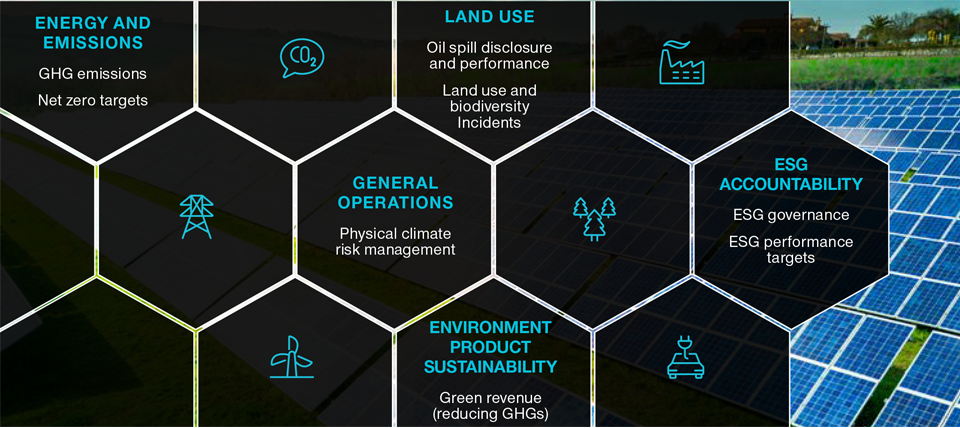
*Non-exhaustive list.
Source: T. Rowe Price
Energy Transition in Stewardship Activity
In 2021, we held 207 engagements where greenhouse gas emissions was a topic for discussion. We continue to guide companies toward industry best practice disclosure standards—including advocating for disclosures aligned to the Sustainability Accounting Standards Board and the Task Force on Climate‑Related Financial Disclosures (TCFD). These are globally recognized frameworks that emphasize financial materiality. We also continued to emphasize the importance of reporting of scope 1–3 GHG emissions data.
Proxy voting played an important role in our stewardship activities around energy transition in 2021. Climate‑related shareholder resolutions were prominent, particularly within high‑impact industries, such as the energy, industrials, and financials sectors. According to data from sustainability organization Ceres, there were 136 climate‑related shareholder proposals tabled between July 1, 2020, and March 31, 2021,13 with just under half of these progressing to a vote at the respective company annual general meetings (AGM).
Climate‑Related Resolutions—Voting Examples
ExxonMobil
AGM–May 26, 2021
T. Rowe Price Voted—For
- ExxonMobil faced a contested director election and seven shareholder resolutions, six of which related in some measure to environmental issues. This highly unusual meeting was the result of many factors, not least being the company’s general resistance to genuine investor engagement and a perception by investors that it is an outlier on climate transition strategy.
- T. Rowe Price supported three of the four board nominees proposed by the dissident investor. We also supported a shareholder resolution seeking independent board leadership, one for increased shareholder authority to convene meetings, one for climate scenario analysis reporting, and three seeking better transparency on the company’s lobbying on climate issues and general political giving. We did not support a resolution brought by an investor who opposes any efforts to mitigate climate risk.
- Apart from the anti-environmental proposal, all the resolutions received strong support from shareholders. In addition, three incumbent directors were replaced.
Mitsubishi UFJ Financial Group
AGM–June 29, 2021
T. Rowe Price Voted—Against
- Kiko Network, a Japanese NGO,* along with three individual shareholders, filed a proposal requesting that Mitsubishi UFJ Financial Group (MUFG) amend its articles to disclose a plan to align the company’s strategy with the goals of the Paris Agreement.
- Subsequent to the filing of this shareholder resolution, MUFG announced a Carbon Neutrality Declaration, aiming for net zero emissions from its finance portfolio by 2050 and in its own operations by 2030. To facilitate this goal, MUFG became the first Japanese bank to join the Net Zero Banking Alliance.
- T. Rowe Price is an active member of the Asian Corporate Governance Association (ACGA). The ACGA-hosted dialogue between the company and the proponent, Kiko Network, informed our vote decision.
- The company’s commitments meant that the resolution had effectively already been addressed, so we did not support it. At the AGM on June 29, 2021, the item received 23% support.
*Nongovernmental organization. A nonprofit organization that operates independently of any government, typically with the purpose of addressing a social or political issue.
The securities identified and described are intended to illustrate the case‑by‑case analysis of climate‑related shareholder proposals by T. Rowe Price’s governance and responsible investing teams and do not necessarily represent all of the securities purchased or sold by T. Rowe Price. No assumptions should be made that the securities mentioned were or will be profitable. This is not a recommendation to buy or sell any security. The views and opinions above are as of the AGM date noted and are subject to change.
Source: T. Rowe Price.
The analysis of climate‑related shareholder proposals by our governance and responsible investing teams is conducted on a case‑by‑case basis. To reach a vote recommendation, we consider:
- The specific circumstances of each company (including the current level of disclosure)
- The company’s climate strategy
- The materiality of the issue for the company, i.e., the extent to which it relates to the company’s operations
We are unlikely to support resolutions that are excessively prescriptive (be they climate‑related proposals or otherwise), as this usually equates to the proponent, in essence, attempting to micromanage the company. Similarly, if we think that the company is already taking sufficient action to address the stated concerns, we will likely withhold our support.
While the nature of our assessment of a company’s actions can vary according to the region and industry, specific measures we consider include those detailed on the right.
In 2022, T. Rowe Price plans to step up its current voting against directors who fail in the oversight of material environmental, social, or governance risks. Companies in sectors that are highly exposed to the impact of climate change and that have failed to demonstrate sufficient preparedness for a low‑carbon transition will be in scope for a vote against the board chair or other relevant committee member.
Framework for Assessment of Climate‑Related Action
ASSESS LEVEL OF DISCLOSURE
- Identify if GHG emission disclosures are TCFD aligned.
- At a minimum, report scope 1 and 2 GHG emissions.
IDENTIFY EMISSIONS TARGETS
- Seek GHG emission reduction targets.
- Ideally, targets are aligned with goals of the Paris Agreement.
EVALUATE CLIMATE STRATEGY
- Assess if company has a credible decarbonization plan.
- Best practice includes a net zero 2050 carbon emissions target (or national/ regional equivalent). A path to achieving the target is key.
CONSIDER ENGAGEMENT ACTIVITY
- Assess responsiveness to stakeholder concerns, including willingness to engage and reflect feedback.
- Determine if company demonstrates robust governance procedures around direct and indirect policy advocacy, including board oversight.
For illustrative purposes only and subject to change.
Important Information
This material is being furnished for general informational and/or marketing purposes only. The material does not constitute or undertake to give advice of any nature, including fiduciary investment advice. Prospective investors are recommended to seek independent legal, financial and tax advice before making any investment decision. T. Rowe Price group of companies including T. Rowe Price Associates, Inc. and/or its affiliates receive revenue from T. Rowe Price investment products and services. Past performance is no guarantee or a reliable indicator of future results.. The value of an investment and any income from it can go down as well as up. Investors may get back less than the amount invested.
The material does not constitute a distribution, an offer, an invitation, a personal or general recommendation or solicitation to sell or buy any securities in any jurisdiction or to conduct any particular investment activity. The material has not been reviewed by any regulatory authority in any jurisdiction.
Information and opinions presented have been obtained or derived from sources believed to be reliable and current; however, we cannot guarantee the sources’ accuracy or completeness. There is no guarantee that any forecasts made will come to pass. The views contained herein are as of the date written and are subject to change without notice; these views may differ from those of other T. Rowe Price group companies and/or associates. Under no circumstances should the material, in whole or in part, be copied or redistributed without consent from T. Rowe Price.
The material is not intended for use by persons in jurisdictions which prohibit or restrict the distribution of the material and in certain countries the material is provided upon specific request. It is not intended for distribution to retail investors in any jurisdiction.
USA—Issued in the USA by T. Rowe Price Associates, Inc., 100 East Pratt Street, Baltimore, MD, 21202, which is regulated by the U.S. Securities and Exchange Commission. For Institutional Investors only.
© 2024 T. Rowe Price. All Rights Reserved. T. ROWE PRICE, INVEST WITH CONFIDENCE, and the Bighorn Sheep design are, collectively and/or apart, trademarks of T. Rowe Price Group, Inc.